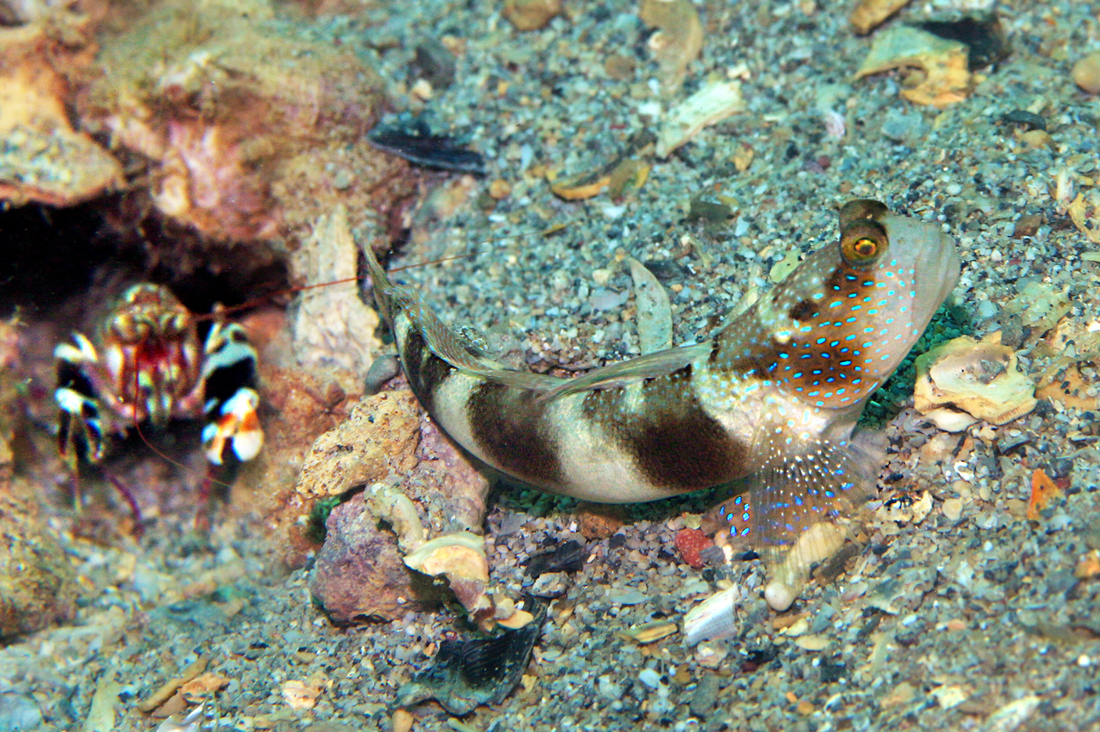Y-bar Shrimpgoby, Cryptocentrus fasciatus (Playfair 1866)
Other Names: Black Shrimp-goby, Blue Finned Shrimp Goby, Y-bar Shrimp Goby

A Y-bar Shrimpgoby, Cryptocentrus fasciatus, Point Murat, Exmouth Gulf, Western Australia, November 2019. Source: Glen Whisson / iNaturalist.org. License: CC by Attribution-NonCommercial
Summary:
A pale greyish, yellow or blackish shrimpgoby with five broad brown y-shaped bars, and bluish-white dashes on the head becoming spots on the body, dorsal fin without markings. The Y-bar Shrimpgoby shares burrows with alpheid shrimps
Cite this page as:
Dianne J. Bray, Cryptocentrus fasciatus in Fishes of Australia, accessed 02 Apr 2025, https://fishesofaustralia.net.au/Home/species/99
Y-bar Shrimpgoby, Cryptocentrus fasciatus (Playfair 1866)
More Info
|
Distribution |
Shark Bay, Western Australia, around the tropical north to One Tree Island, southern Great Barrier Reef, Queensland; also reefs in the Coral Sea. Elsewhere the species occurs in the tropical, Indo-west Pacific from east Africa to Shares burrows with alpheid shrimps in sandy areas on coastal and inner reef slopes and near patch reefs. |
|
Features |
Dorsal fin VI-VII, 10; Anal fin I, 9. greatest depth of body 5.5-5.8 in SL; united pelvic fins, presence of frenum; longitudinal scale series 77-92; absence of scales on head except a few scales dorsally on opercle; rounded caudal fin, 3.2-3.8 in SL |
|
Colour |
Rangesing from yellow, barred or mottled to blackish, dorsal fins unmarked; barred variety with four brown saddles, head with white or bluish streaks, plain dorsal fins, pelvic fins with blue spots, blue stripe on anal fin; saddled variety dark brown colour with whitish saddles on top of head and along back; head with small white or blue spots or streaks, pelvic fins with blue spots, blue stripes on anal fins; mottled variety with four diffuse brown bars on side; lower operculum with large brown blotch, head with white to bluish spots, strong mottling on back, anal fin with blue stripes. |
|
Similar Species |
Similar to the Yellow Shrimpgoby, Cryptocentrus cinctus, which has bluish streaks on the dorsal fin. |
|
Species Citation |
Gobiosoma fasciatum Playfair in Playfair & Günther 1866, Fishes of Zanzibar: 72. Type locality: Zanzibar. |
|
Author |
Dianne J. Bray |
|
Resources |
Y-bar Shrimpgoby, Cryptocentrus fasciatus (Playfair 1866)
References
Allen, G.R. & Erdmann, M.V. 2012. Reef fishes of the East Indies. Perth : Tropical Reef Research 3 vols, 1260 pp.
Hoese, D.F., Shibukawa, K. & Sakaue, J. 2011. A redescription of the gobiid fish Cryptocentrus sericus Herre, with clarification of Cryptocentrus leptocephalus and C. melanopus. Aqua, International Journal of Ichthyology 17(3): 163-172. PDF
Hutchins, B. 2004. Fishes of the Dampier Archipelago, Western Australia. Records of the Western Australian Museum, Supplement 66: 343–398.
Kuiter, R.H. 1992. Tropical Reef-Fishes of the Western Pacific, Indonesia and Adjacent Waters. Jakarta : PT Gramedia Pustaka Utama 314 pp. pls.
Larson, H.K., Williams, R.S. & Hammer, M.P. 2013. An annotated checklist of the fishes of the Northern Territory, Australia. Zootaxa 3696(1): 1-293.
Playfair, R.L. in Playfair, R.L. & Günther, A. 1866. The Fishes of Zanzibar. London : John van Voorst 146 pp. 21 pls.
Randall, J.E. 2005. Reef and shore fishes of the South Pacific. New Caledonia to Tahiti and the Pitcairn Islands. Honolulu : University of Hawaii Press 707 pp.
Randall, J.E., Allen, G.R. & Steene, R. 1990. Fishes of the Great Barrier Reef and Coral Sea. Bathurst : Crawford House Press 507 pp. figs.
Randall, J.E., Allen, G.R. & Steene, R. 1997. Fishes of the Great Barrier Reef and Coral Sea. Bathurst : Crawford House Press 557 pp. figs.
Russell, B.C. 1983. Annotated checklist of the coral reef fishes in the Capricorn-Bunker group, Great Barrier Reef, Australia. Great Barrier Reef Marine Park Authority. Special Publication Series 1: 1-184 figs 1-2
Smith, J.L.B. 1959. Gobioid fishes of the families Gobiidae, Periophthalmidae, Trypauchenidae, Taenioididae and Kraemeriidae of the western Indian Ocean. Ichthyological Bulletin of the J.L.B. Smith Institute, Grahamstown 13: 185-225 figs 1-42 pls 9-13










